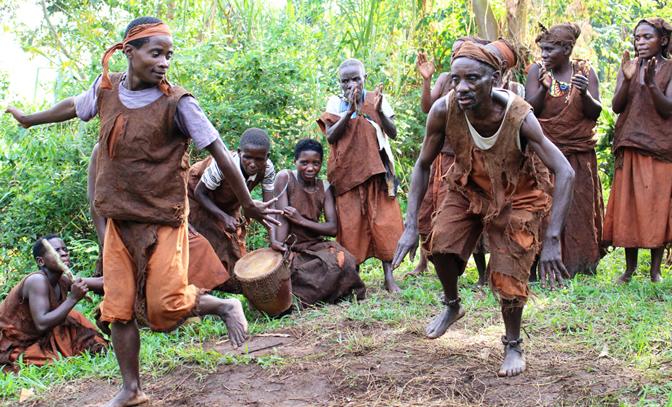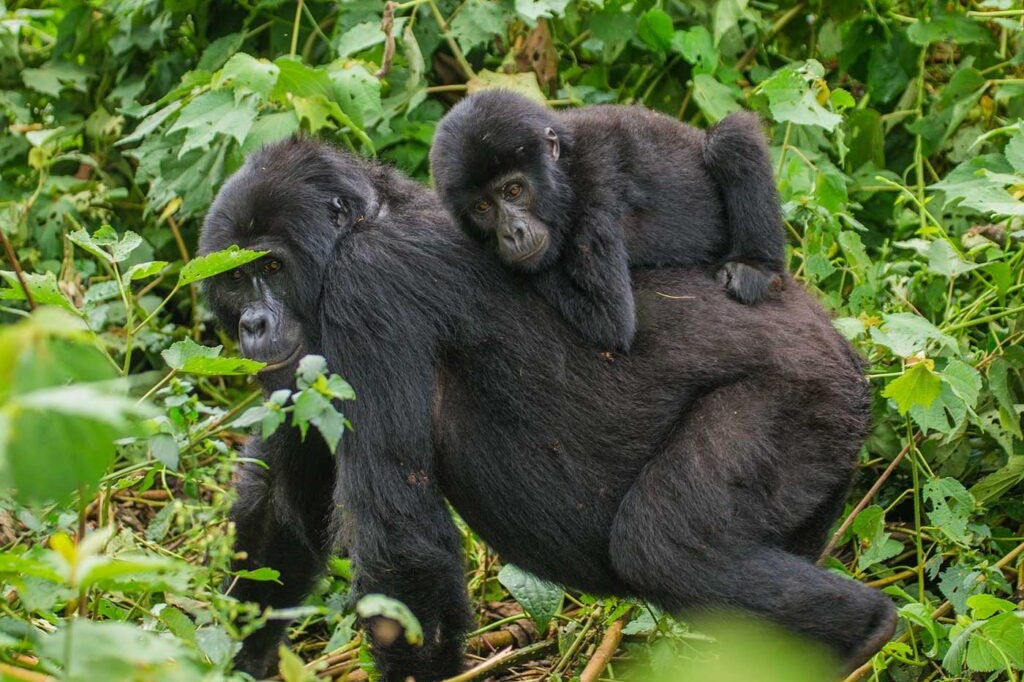- Home
- Uganda
- Gorilla Trekking Safaris
- 15 Day Gorillas – Chimps and Big 5 Safari
- 14 Day Uganda-Rwanda Wildlife & Primates Safari
- 10 Day Uganda Wildlife and Primates Safari
- 10 Day Highlights of Uganda Safari
- 8-Day Uganda Gorilla – Chimpanzee and Big Five Safari
- 7 Day Murchison Falls with Chimps and Gorillas
- 6 Day Gorillas and Lake Mburo Safari
- 6 Day Gorilla Trekking and Queen Elizabeth
- 5 Day Gorillas and White Water Rafting Safari
- 3 Day Uganda Fly to Bwindi Gorilla Safari
- 3 Day Gorilla Trekking and Batwa Trails in Bwindi
- 3 Day Gorillas and Lake Bunyonyi Safari
- Wildlife Safaris
- 22 Days Best of Uganda Wilderness Adventure
- 18 Day Exploring Uganda Safari
- 15 Day Uganda – Kenya -Tanzania Adventure
- 14 Days Uganda & Kenya Wildlife Safari
- 12 Day Mountain Rwenzori Trekking and Wildlife
- 11 Day Uganda Classic Honeymoon Safari
- 7 Day Sipi Falls and Kidepo Valley National Park
- 4 Day Kibale Forest Chimpanzee Tracking
- 3 Days Queen Elizabeth Wildlife Safari
- 3 Day Murchison Falls with Big 5 Adventure
- 3 Day Best of Jinja Safari Adventure
- Birding & Fishing Tours
- 21 Days Birding Uganda and Gorilla Trekking Safari
- 18 Days Birding Tour with Gorilla Trekking
- 15 Days Uganda Birding Safari with Gorillas and Chimps
- 10 Day Birding Uganda and Game Drives
- 10 Day Uganda Fishing Safari with a Boat Cruise
- 4 Day Murchison Falls Fishing Safari
- 3 Day Mabamba Shoebill Birding Safari
- Gorilla Trekking Safaris
- Rwanda
- Kenya
- Tanzania
- Long Safaris
- 15 Day Uganda – Kenya and Tanzania Safari Holiday
- 14 Day Tanzania Wildlife Safari & Pangani Beach Holiday
- 10 Day Wildlife and Kilimanjaro Cultural Safari
- 9 Day Kilimanjaro Hiking Safari in Tanzania
- 9 Day Highlights of Tanzania Safari
- 8 Day Best of Tanzania Wildlife Safari
- 8 Day Classic Honeymoon Package with Zanzibar
- Short Safaris
- Long Safaris
- National Parks
- Uganda
- Rwanda
- Kenya
- Tanzania
- Serengeti National Park
- The Ngorongoro Conservation Area
- Tarangire National Park
- Lake Manyara National Park
- Mount Kilimanjaro National Park
- Arusha National Park
- Gombe National Park
- Katavi National Park
- Kitulo National Park
- Mahale Mountains National Park
- Mikumi National Park
- Mkomazi National Park
- Nyerere National Park (Selous)
- Ruaha National Park
- Rubondo Island National Park
- Saadani National Park
- Udzungwa Mountains National Park
- Blog & Tips
- About Us
- Contact


 Bwindi Impenetrable Rainforest the few forests in Africa which still flourished even in the last ice age. It covers an area of about 331 square kilometers at an altitude of 1,160 meters-2,607 meters within the Ishasha gorge, up the Rwamanyonyi Peak.
Bwindi Impenetrable Rainforest the few forests in Africa which still flourished even in the last ice age. It covers an area of about 331 square kilometers at an altitude of 1,160 meters-2,607 meters within the Ishasha gorge, up the Rwamanyonyi Peak. This is the most interesting activity in Bwindi Impenetrable National Park which has attracted many tourists hence promoting more gorilla visits in Uganda; Bwindi has about 14 habituated gorilla families but currently, gorilla trekking is mainly carried out in the southern part of Bwindi in the regions of Nkuringo and Rushaga.
This is the most interesting activity in Bwindi Impenetrable National Park which has attracted many tourists hence promoting more gorilla visits in Uganda; Bwindi has about 14 habituated gorilla families but currently, gorilla trekking is mainly carried out in the southern part of Bwindi in the regions of Nkuringo and Rushaga. Bwindi impenetrable forest is a habitat to about 350 bird species for example the Blue-headed sun-bird, short-tailed warbler, Red headed Blue-Bil, White-tailed blue flycatchers, the attractive African Emerald cuckoo and many others. Therefore through hiking and trekking within the forest, you will be able to view these various bird species. The ancient rainforest of Bwindi Impenetrable National Park provides more habitats for other unique bird species including 23 Albertine rift endemics.
Bwindi impenetrable forest is a habitat to about 350 bird species for example the Blue-headed sun-bird, short-tailed warbler, Red headed Blue-Bil, White-tailed blue flycatchers, the attractive African Emerald cuckoo and many others. Therefore through hiking and trekking within the forest, you will be able to view these various bird species. The ancient rainforest of Bwindi Impenetrable National Park provides more habitats for other unique bird species including 23 Albertine rift endemics.
 Hiking through the Bwindi Impenetrable forest is very interesting and as you enjoy the nature walk, you will be accompanied by fantastic views of various beautiful bird species singing in the air, butterflies, the beautiful sceneries of the ever green vegetation and waterfalls within the forest; You will also be able to see the chimpanzees, black and white colobus monkeys as well as other primates. Buhoma region of Bwindi has six main hiking trails and these include; muyanga waterfall trail, Rushura hill walk, Muzubijiro loop trail, Buhoma-Nkuringo trail, the ivi river walk, and the Habinyanja trail.
Hiking through the Bwindi Impenetrable forest is very interesting and as you enjoy the nature walk, you will be accompanied by fantastic views of various beautiful bird species singing in the air, butterflies, the beautiful sceneries of the ever green vegetation and waterfalls within the forest; You will also be able to see the chimpanzees, black and white colobus monkeys as well as other primates. Buhoma region of Bwindi has six main hiking trails and these include; muyanga waterfall trail, Rushura hill walk, Muzubijiro loop trail, Buhoma-Nkuringo trail, the ivi river walk, and the Habinyanja trail.



